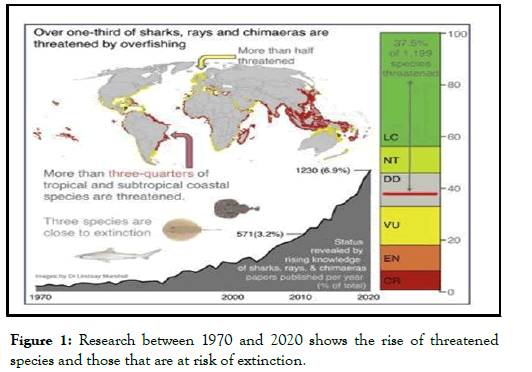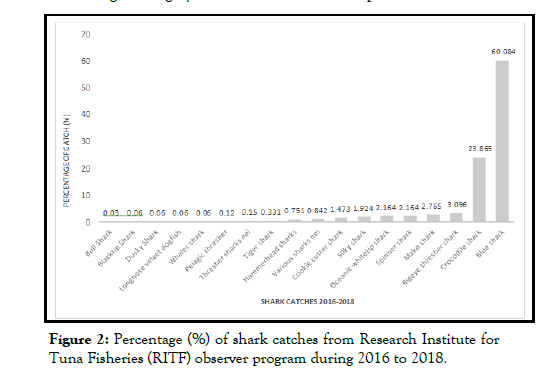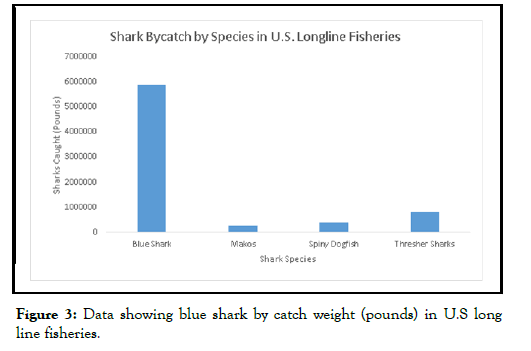The effects of fishing on declining numbers of pelagic shark species, with special emphasis on the blue shark (Prionace Glauca)
Received: 06-Jul-2022, Manuscript No. PULJAFM-22-5132; Editor assigned: 08-Jul-2022, Pre QC No. PULJAFM-22-5132(QC); Reviewed: 22-Jul-2022 QC No. PULJAFM-22-5132; Revised: 05-Sep-2022, Manuscript No. PULJAFM-22-5132(R); Published: 12-Sep-2022
Citation: Cimino A. The effects of fishing on declining numbers of pelagic shark species, with special emphasis on the blue shark (Prionace glauca). J Aqua Fish 2022;2(7):1-4.
This open-access article is distributed under the terms of the Creative Commons Attribution Non-Commercial License (CC BY-NC) (http://creativecommons.org/licenses/by-nc/4.0/), which permits reuse, distribution and reproduction of the article, provided that the original work is properly cited and the reuse is restricted to noncommercial purposes. For commercial reuse, contact reprints@pulsus.com
Abstract
The blue shark (Prionace glauca) has long thought to be a species of shark capable of withstanding global fishing pressures, but the data collected in recent years is showing that blue sharks may be succumbing to those pressures. Long line fishing is responsible for high numbers of blue sharks being caught as incidental bycatch with their populations dropping by 60% in the North Atlantic alone. These declines in population are a cause for concern with the blue shark playing a key role within the global ocean. The rising demand for shark meat and fins also places unsustainable pressure on the blue shark, with them being a highly targeted species of shark for their large pectoral fins. The demand for their meat in Brazil has risen dramatically by 40% during the years of 2000 and 2011. With the blue shark only being listed as near threatened by the IUCN and not appearing on cities appendix I or II they are not considered a species that are at risk, yet data seems to be indicating otherwise. The rising interest in shark based eco-tourism could be a potential measure to aid the conservation of this species and educate the public regarding the importance of marine predators like the blue shark.
Keywords
Conservation; Marine predators; Prionace glauca; Populations dropping; Eco-tourism
Introduction
Global populations of pelagic shark species have been in steady decline due to overfishing and certain fishing methods, specifically long lining and as a result bycatch. Pelagic species of sharks have declined specifically within the Mediterranean by 96-99% due to lack of species protection and conservation indicating measures need to be taken to implement policy change. Overfishing has become an increased cause of concern for chondrichthyes which include sharks, skates, and rays with over one third facing extinction (Figure 1). One species particularly over exploited is the blue shark Prionace glauca which is listed as near threatened globally and critically endangered within the Mediterranean by the International Union for Conservation of Nature (IUCN) [1].
Figure 1: Research between 1970 and 2020 shows the rise of threatened species and those that are at risk of extinction.
Mortality rates of sharks because of longline fishing methods, means that 23 species of shark are now at risk of extinction within the vast geographical range of the Mediterranean. Many fishing methods like commercial longlines put sharks at risk of being captured incidentally as bycatch, this is problematic for many pelagic species, especially those with low fecundity. The blue shark is one species most at risk due to being a highly migratory species, with their incidental bycatch capture rates estimated at 6.5-11 million individuals per year. The other downfall of being such a highly migratory species means that the blue shark is also a prime target within the shark meat market, even though they are one of the most exploited shark species blue sharks still lack much needed protection on a global scale. The blue shark is also considered a prime target within the global fin trade. In this paper the following topics will be discussed, the issues blue sharks are facing due to fishing methods especially bycatch mortality from longline fisheries, blue shark biology, the implications from lack of conservation measures for the blue shark and how these issues could potentially be addressed [2-6].
Materials and Methods
Biology and ecology of the blue shark (Prionace glauca )
The blue shark Prionace glauca is a large, predatory species of shark that is found within temperate and tropical marine ecosystems and is one of the most abundant species within oceanic fisheries. Understanding their biology especially reproduction is key when evaluating the impacts of fishing on their population numbers. They are a well recognized species morphologically with large pectoral fins, a long torpedo shaped body and bright, metallic blue, dorsal side colouring. This viviparous species has a mean of 30 pups per year with a 9-12 month gestation period, with a relatively short growth rate from juvenile to adult with females becoming sexually mature at 5-7 years and males at 4-6 years. Being a species that is highly susceptible to becoming incidental bycatch from longline fishing, research has shown that if a pregnant female has endured stress during the fishing process, litter size may be lower than average due to mortality of pups in the uterus. The blue shark is a key cosmopolitan species with a varied diet ranging in many different taxa and will often exhibit scavenging feeding behaviour throughout the open ocean. They are an ocean epipelagic species and are of ecological importance with a diet consisting mainly of cephalopods, crustaceans, sea birds, teleost fishes and cetaceans, making them a top predator. A study conducted in the Central Eastern Pacific Ocean found that all blue sharks from a total of 80 specimens, 43% female and 57% male that were studied contained levels of Mercury (Hg) within in their tissue. The concentration of Hg found within the muscle tissue of the blue shark correlates with their diet that includes cuttlefish and squid, with toxic metals like Hg bioaccumulating throughout each level of the food chain [7].
Fishing methods and the impact on blue shark populations
Overfishing poses perhaps the greatest threat to marine life and habitats, with sharks being one of the most susceptible to its damaging effects. This is because most shark species have low reproductive rates and therefore are unable to replenish populations quickly enough [8].
Commercial longline fishing is a problematic fishing method for many pelagic shark species throughout the global ocean with the blue shark being amongst the most susceptible.
In the Indian Ocean alone the estimated catch of blue sharks by longline tuna fisheries yearly is 366.3-2,616 tons with a mean of 1,283 tons and 60% of all bycatches being the blue shark (Figure 2). There are growing concerns over total blue shark stock numbers as a result of pressure from fishing exploitation within the Indian Ocean. In Brazil, the blue shark is the most common elasmobranch bycatch from pelagic longline fisheries, with them accounting for roughly 25% in total out of seven species.
Research has shown that bycatch numbers in Brazil have increased from 6.4% in 2004 to over 20% in 2009. Within the Atlantic, it was reported to ICCAT (International Commission for the Conservation of Atlantic Tunas) that blue sharks account for more than 50% of the total catch within longline fisheries, resulting in them accounting for 85-90% of the total elasmobranch catch. Analysis showed that the blue shark was among the most common species caught as by catch by Canadian long line fisheries based in the Northwest Atlantic, even though the target species was swordfish and tuna. Overall, within the western North Atlantic blue shark numbers have dropped by 60% since the 1980’s, yet actual stock numbers are incomplete due to lack of data from fisheries. Long line fishing operations in Taiwan recorded that the blue shark was the most common shark species caught as incidental by catch, with 3.9-10.3% of overall by catch being pelagic sharks. U.S long line fisheries also play a large role in the exploitation of the blue shark; research has shown that the blue sharkaccounts for 90% of the incidental bycatch in just one single fishery (Figure 3). Which in 2010 amounted to 3,000 tonnes. Spanish and Portuguese longline fishing fleets that specifically target tuna and swordfish Xiphias gladius found that 60% of their catch was blue shark. The estimated number for global blue shark by catch is 86,000 tonnes annually, demonstrating how vastly over exploited the blue shark is as a species. With the growing rates of overfishing putting pressure on shark species, it is believed that those caught specifically for the fin trade are at a higher risk of extinction and those with a lower rebound rate becoming endangered [9,10].
In an effort to limit blue shark interaction with fishing gear, the use of magnets composed mainly of neodymium has been proposed, but a study showed that the desired effect of repelling the sharks via an electromagnetic field was not achieved and could potentially have the opposite affect and attract them. Implications of longline fisheries go further than a high bycatch mortality rate for blue sharks, a research study conducted in the Mediterranean between 2017 and 2020 found that 50% of blue sharks that were filmed via a BRUV deployment had residual hooks in their mouths. Residual hooks found in sharks can cause a plethora of health issues for the animal ranging from hepatitis to gastric perforation, those sharks found with hooks in their mouths had either broken free from long lines or had the line cut by fishers onboard the vessel. Alongside residual hooks, plastic pollution, and entanglement from longlines has shown to cause further issues for the blue shark with the debris often getting wrapped around their gills as well as posing damage to their pectoral and dorsal fins [11-15].
Blue shark meat and its global growing demand
There is growing concern over the trade of blue shark meat, with the species going from a non-targeted species to a targeted species, with shark meat consumption having grown by 42% between 2000 and 2011. In Brazil, shark meat is generally labelled as “cacao” regardless of the species being sold, some of which may be an endangered species. Among the shark meat sold and consumed in Brazil, a study found that the blue shark was the most prevalent species found. Blue shark is also commonly sold in Spain, Italy and France all labelled under different names depending on the region. The renaming of species in the shark meat market was introduced as a way of making low quality fish more desirable to the consumer. Within the shark fin industry in Hong Kong and China, the blue shark is among the most common species traded, with the fins being imported then dried for use in shark fin soup [16-20].
Being a meso pelagic predator, blue shark tissue has been found to contain high contaminate levels of Hg (Mercury) that were well above the average consumption limits stated by the Hong Kong center for food safety [21-25].
Results and Discussion
During a DNA barcoding study in Singapore, 296 tissue samples were obtained and tested, with the blue shark being among the most abundant species discovered. The demand for blue shark meat seems to be a growing market, with the catch of this species increasing by 62,00 tons annually from Chinese long line fisheries alone. Despite data having shown that blue sharks are being subjected to heavy fishing pressures globally, they are not listed under CITIES appendices I or II and under the IUCN red list they only fall under near threatened, which indicates a potential need for reassessment to include the species on CITIES appendix II [26-30].
Conservation issues and the potential measures to be taken for the blue shark: One of the issues faced when it comes to conservation of many shark species is lack of support from the public due to many media outlets, news publications, and movies painting sharks in a negative light. Many news and media based sources will often use baiting language that often instills fear in people and does not give an accurate representation of the shark species being discussed. This can cause issues for shark conservation with a negative preempted perception of sharks within the public eye. In contrast to this, since 2011, there has been a rise in ecotourism, specifically shark based ecotourism, allowing those that take part to gain a better understanding of sharks, their biology, and the important role they play within marine ecosystems. Eco tourism in the form of shark diving is a growing industry which could positively impact local economies where the diving takes place, this in turn could benefit the species being encountered. The blue shark has become a point of interest over recent years with people wanting to interact with this species in their natural habitat via ecotourism, which in the long term could benefit blue sharks and change many preconceived perceptions about sharks overall. A particular area of interest for blue shark diving is in the Azores Islands, the ecotourism industry within this area does not only benefit blue sharks, but also local businesses and economy. In contrast, the water within the Azores where it is popular for shark-diving opportunities is also a historically heavily fished area by industrial long-line fleets. Shark based ecotourism is a growing industry that has significant beneficial impacts on the local economy, with $2 million USD being generated within the Azores in 2014 alone [31,32].
Shark diving as a potential conservation measure has been studied in other areas of the globe with species such as the white shark. A particular study conducted with 136 participants who were cage diving with white sharks in South Australia showed that 69% of the divers became more active in shark conservation after the experience. Shark tourism has the ability to encourage conservation by educating the public regarding the huge threats that sharks are facing globally [33-38].
Conclusion
Sharks have experienced significant declines over the past 50 years due to overfishing and a rise in shark fin and shark meat demand. The blue shark is an important predatory species within the global oceans eco systems and is considered a keystone species. The last stock assessment of the blue shark by the IUCN (International Union for Conservation of Nature) was in 2016, yet as data and research has shown the numbers of overexploitation of this species has risen dramatically. This indicates a potential need for a reassessment of species stock in order to move forward with conservation measures before populations decline further. The blue shark has often been overlooked due to being a highly migratory species that was believed to be abundant in numbers and repopulate even under large fishing pressures, however as studies have shown, the rise in demand for shark products on a global scale means this species is at risk. Implementing change for fisheries interactions with sharks and specifically the number of landings and bycatch is a long process, yet necessary for species such as the blue shark that fall high on the list of incidental bycatches of elasmobranchs. Education surrounding the blue shark and their biology is also a key factor in being able to implement much needed conservation of the species. As shark tourism popularity rises within areas like the Azores which targets interactions with the blue shark, it could benefit the species by way of education. Another positive outcome of ecotourism is the financial gain and job opportunities for the local economy, with currency being a key driver it could significantly benefit those involved. The ecotourism industry has shown it is within the interest of those running shark diving operations, to help conserve the species of shark that divers will pay to see in their natural habitats.
An example of how ecotourism can aid an at risk species is the white shark (Carcharodon carcharias), which after experiencing huge pressures from being a targeted species of shark, is now listed as protected in countries such as Australia and America. With blue sharks inhabiting most oceans across the globe, ecotourism in the form of shark diving could be a beneficial path for their conservation with them being targeted for diving opportunities, not for consumption.
References
- Abril AM, Siu G, Torres A, et al. Fisheries independent evidence of long line fisheries impact on the threatened mediterranean blue shark prionace glauca in the waters around the balearic islands (Spain). Ocea Fish Oceanogr J. 2020;12(3):81-7.
- Adams GD, Flores D, Flores OG, et al. Spatial ecology of blue shark and shortfin make in southern Peru: local abundance, habitat preferences and implications for conservation. Endanger Species Res. 2016;5(31):19-32.
[Googlescholar] [Indexed]
- Aires-da-Silva AM, Hoey JJ, Gallucci VF, et al. A historical index of abundance for the blue shark (Prionace glauca) in the western North Atlantic. Fish Res. 2008;92(1):41-52.
- Apps K, Dimmock K, Huveneers C, et al. Turning wildlife experiences into conservation action: Can white shark cage dive tourism influence conservation behaviour. Mar Policy. 2018; 88:108-15.
- Apps K, Dimmock K, Lloyd DJ, et al. Is there a place for education and interpretation in shark-based tourism. Tour Recreat Res. 2017; 42(3):327-43.
- Bargnesi F, Lucrezi S, Ferretti F, et al. Opportunities from citizen science for shark conservation, with a focus on the Mediterranean Sea. Eur Zool J. 2020;87(1):20-34.
- Bernardo C, de Lima Adachi AM, da Cruz VP, et al. The label “Cacao” is a shark or a ray and can be a threatened species Elasmobranch trade in Southern Brazil unveiled by DNA barcoding. Mar Policy. 2020;116:103920.
- Bettis SE. A capstone paper submitted in partial fulfillment of the requirements for the degree of masters of science: Marine Biology. Semanticscholar; 2017.
- Bu Y, Elango J, Zhang J, et al. Immunological effects of collagen and collagen peptide from blue shark cartilage on 6T-CEM cells. Proce Biochem. 2017;57:219-27.
- Bustamante C, Bennett MB. Insights into the reproductive biology and fisheries of two commercially exploited species, shortfin mako (Isurus oxyrinchus) and blue shark (Prionace glauca), in the south-east Pacific Ocean. Fish Res. 2013;143:174-83.
- Carruthers EH, Neilson JD, Smith SC, et al. Over looked by catch mitigation opportunities in pelagic longline fisheries: Soak time and temperature effects on swordfish (Xiphias gladius) and blue shark (Prionace glauca) catch. Fisheries Res. 2011;108(1):112-120.
- Castro-Rendón RD, Calle-Morán MD, García-Arévalo I, et al. Mercury and cadmium concentrations in muscle tissue of the blue shark (Prionace glauca) in the central eastern Pacific Ocean. Biol Trace Elem Res. 2022;200(7):3400-11.
[Crossreff] [Googlescholar] [Indexed]
- Coelho R, Infante P, Santos MN, et al. Comparing GLM, GLMM, and GEE modeling approaches for catch rates of bycatch species: A case study of blue shark fisheries in the South Atlantic. Fish Oceanography. 2020;29(2):169-84.
- Colmenero AI, Barría C, Broglio E, et al. Plastic debris straps on threatened blue shark Prionace glauca. MarPollut Bullet. 2017;115(1-2):436-8.
- Cordova-Zavaleta F, Mendo J, Briones-Hernandez SA, et al. Food habits of the blue shark, Prionace glauca (Linnaeus, 1758), in waters off northern Peru. Fishery Bulletin. 2018;116(3-4):310-24.
- da Silva TE, Lessa R, Santana FM, et al. Current knowledge on biology, fishing and conservation of the blue shark (Prionace glauca). Neotrop Biol Conserv. 2021; 16(1):71-88.
- Dulvy NK, Pacoureau N, Rigby CL, et al. Overfishing drives over one third of all sharks and rays toward a global extinction crisis. Current Biology. 2021;31(21):4773-87.
[Crossreff] [Googlescholar] [Indexed]
- Erhardt T, Weder R. Shark hunting: On the vulnerability of resources with heterogeneous species. Energy Econ. 2020;61:101181.
- Lucena Frédou F, Tolotti MT, Frédou T, et al. Sharks caught by the Brazilian tuna longline fleet: an overview. Rev Fish Biol Fish. 2015; 25(2):365-77.
- Gallagher AJ, Orbesen ES, Hammerschlag N, et al. Vulnerability of oceanic sharks as pelagic longline bycatch. Glob Ecol Conserv. 2014; 1:50-9.
- Barcia LG, Argiro J, Babcock EA, et al. Mercury and arsenic in processed fins from nine of the most traded shark species in the Hong Kong and China dried seafood markets: The potential health risks of shark fin soup. Mar Pollu Bullet. 2020;157:111281.
[Crossreff] [Googlescholar] [Indexed]
- Geng Z, Wang Y, Kindong R, et al. Demographic and harvest analysis for blue shark (Prionace glauca) in the Indian Ocean. Reg Stud Mar Sci. 2021;41:101583.
- Boldrocchi G, Storai T. Data mining social media platforms highlights conservation action for the Mediterranean Critically Endangered blue shark Prionace glauca. Aquatic Conservation. Mar Freshwater Ecosys. 2021;31(11):3087-99.
- Gonzáles-Mantilla PG, Gallagher AJ, León CJ, et al. Economic impact and conservation potential of shark-diving tourism in the Azores Islands. Mar Policy. 2022;135:104869.
- Huang HW, Liu KM. Bycatch and discards by Taiwanese large scale tuna long line fleets in the Indian Ocean. Fish Res. 2010;106(3):261-70.
- Kazama H, Yamaguchi Y, Harada Y, et al. Mercury concentrations in the tissues of blue shark (Prionace glauca) from Sagami Bay and cephalopods from East China Sea. Environ Pollut. 2020;266:115192.
[Crossreff] [Googlescholar] [Indexed]
- Le Busque B, Dorrian J, Litchfield C, et al. The impact of news media portrayals of sharks on public perception of risk and support for shark conservation. Mar Policy. 2021;124:104341.
- Liu CJ, Neo S, Rengifo NM, et al. Sharks in hot soup: DNA barcoding of shark species traded in Singapore. Fish Res. 2021;241:105994.
- Lucena Fredou F, Tolotti MT, Fredou T, et al. Sharks caught by the Brazilian tuna longline fleet: an overview. Rev Fish Biol Fish. 2015; 25(2):365-77.
- Merten Cruz M, Szynwelski BE, Ochotorena de Freitas TR, et al. Biodiversity on sale: The shark meat market threatens elasmobranchs in Brazil. Aquatic Conservation: Mar Freshwater Ecosys. 2020;31(12):3437-50.
- Mucientes G, Queiroz N, et al. Presence of plastic debris and retained fishing hooks in oceanic sharks. Mar Pollut Bullet. 2019;143:6-11.
[Crossreff] [Googlescholar] [Indexed]
- Nakano H, Stevens JD. The biology and ecology of the blue shark, Prionace glauca. Sharks of the open ocean: Biology. Fish and Conserv. 2008;1:140-51.
- Porsmoguer SB, Bănaru D, Boudouresque CF, et al. Hooks equipped with magnets can increase catches of blue shark (Prionace glauca) by longline fishery. Fish Res. 2015;172:345-51.
- Rochman F, Wujdi A, Arnenda GL, et al. Blue sharks (Prionace glauca) by-catch in the Indonesian industrial tuna longline fishery in the eastern Indian Ocean. InIOP Conference Series. Earth Environ Sci. 2021;860(1):012115.
- Torres P, Bolhão N, da Cunha RT, et al. Dead or alive: The growing importance of shark diving in the Mid Atlantic region. J Nat Conserv. 2017;36:20-8.
- Vandeperre F, Aires-da-Silva A, Santos M, et al. Demography and ecology of blue shark (Prionace glauca) in the central North Atlantic. Fish Res. 2014;153:89-102.
- WW LiRK, Wub F, Tianb SQ, et al. Catch rate and stock status of blue shark in the pacific ocean inferred from fishery-independent data. Indian J Mar Sci. 2020;49:543-7.
- Zhu J, Dai X, Xu L, et al. Reproductive biology of female blue shark Prionace glauca in the southeastern Pacific Ocean. Environ Biol Fishes. 2011;91(1):95-102.








